Have you ever heard of fungal acne? Fungal acne is a type of acne that is caused by a type of fungus known as Malassezia. This fungus is found on the skin and can cause inflammation and redness.
In this essay, we will discuss what does fungal acne looks like, what causes it, and how to treat it. symptoms of fungal acne can include a rash, difficulty sleeping, and headaches.

There is no one-size-fits-all cure for fungal acne, but there are several ways to treat it. Some people recommend using over-the-counter treatments like benzoyl peroxide or topical creams. Others recommend using natural treatments like tea tree oil or probiotics. If you have fungal acne, it is important to consult with a dermatologist to see if any of these treatments are right for you.
What Does Fungal Acne Look Like?
Fungal acne can range from mild to severe and may appear as small red bumps, whiteheads, or large, painful nodules. It can also appear as a red rash with white or yellowish spots.
What Causes Fungal Acne?
There is no one-size-fits-all answer to this question, as the cause of fungal acne can vary depending on the person. However, some common causes of fungal acne include hygiene issues such as inadequate washing or wearing of the clothing that traps sweat and bacteria, using harsh soaps or shampoos, and using makeup that contains oil or perfume.
How to Treat Fungal Acne?
There is no one-size-fits-all answer to this question, as the treatment for fungal acne will vary depending on the person. Some people may require over-the-counter treatments like benzoyl peroxide or topical creams. Others may need natural treatments like tea tree oil or probiotics. If you have fungal acne, it is important to consult with a dermatologist to see if any of these treatments are right for you.

What Are the Symptoms of Fungal Acne?
The symptoms of fungal acne can range from mild to severe and can include redness, swelling, and small bumps on the skin. It can also cause a white or yellowish rash with spots or patches.
How Can I Treat Fungal Acne?
Treatment for fungal acne usually involves over-the-counter products, such as moisturizers and cleansers, as well as prescription medications if needed. You should also avoid harsh soaps and products that contain alcohol, as these can cause irritation and inflammation.

Conclusion
Fungal acne is an annoying and potentially dangerous skin condition that needs to be adequately treated to ensure its prevention and elimination. You can get rid of fungal acne quickly and easily with the right treatment plan.
